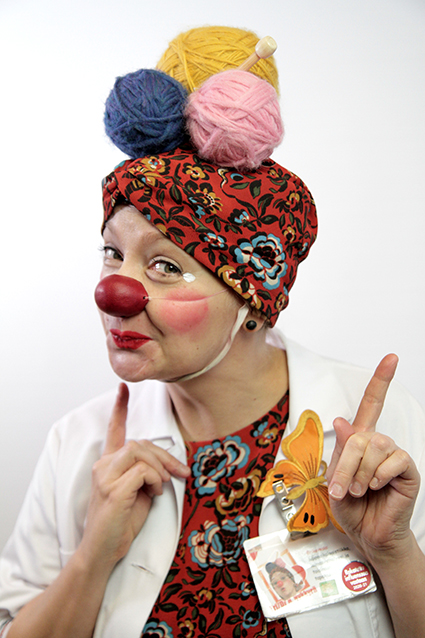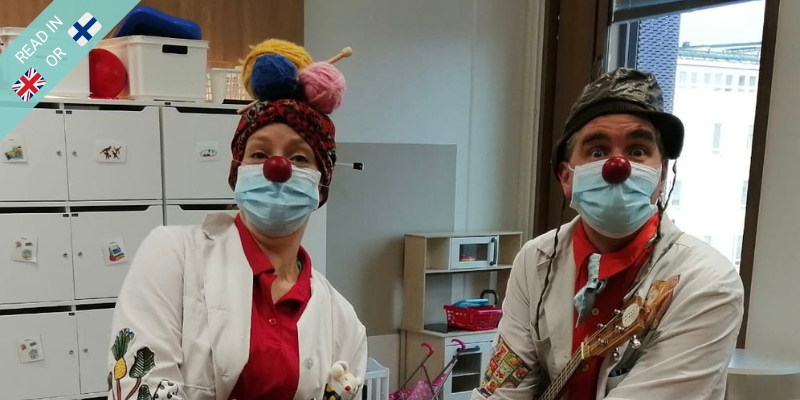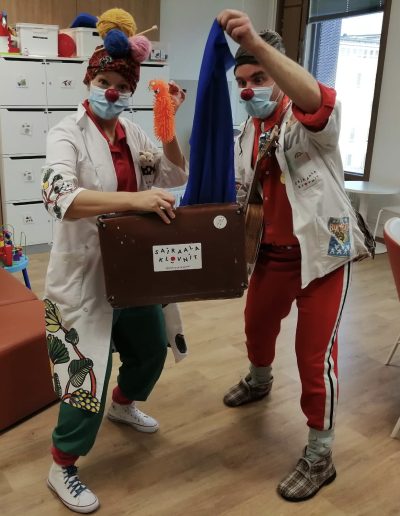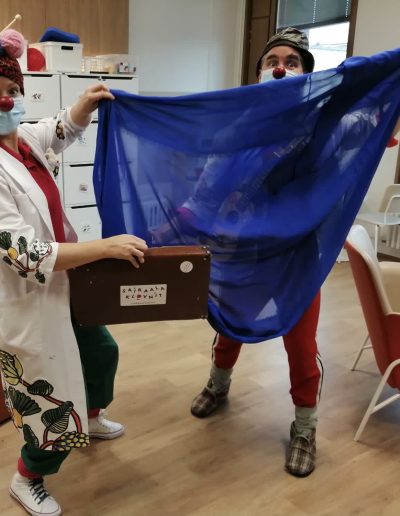Read in Finnish.
The three-year project ClowNexus is entering its last third of its period. Therefore, we asked Elina Reinikka from our project partner Sairaalaklovnit in Finland about her learnings and insights about the work with children with autism.

Dear Elina, what was your experience so far? How did you change as a person and as a clown in working deeper with children with autism?
Elina Reinikka: I could say that I’ve learned to focus on the basics. For me, the most important thing in all human interactions has come to the fore more clearly than before: the moment of contact. It doesn’t matter how “small” or short or through which channel the contact is found, the contact itself, the momentary sharing of connection, is the essence of everything in the encounter between people.
I have become more open to reading messages from body language, gestures, breathing, gaze direction, mood; people communicate just by being. I no longer get anxious so easily if contact is not found quickly, or it is not found with words or other traditional means, I have learned to breathe and wait and see difficulties in communication as positive challenges: “Hmm… Interesting! Here’s a nut to crack! What will be the route through which the two of us will find connection?”
At the same time, I find that I’ve become more cautious of the use of social games and roles and hidden messages beneath speech because they are not readable for everybody. I find that I enjoy the directness with which children on the autism spectrum communicate. The joy of finding a connection has also grown bigger and I can enjoy it as an independent, absolute value, without any agenda to which the connection should lead.
What have been your three major learnings up to this point in interacting with children with autism?
Elina Reinikka: First of all – everyone has a desire to communicate and each individual channel for communication can be found and supported. Second, the problems of interaction can be seen as interesting challenges: what different senses can I use when I look for contact? Can the moment of contact be found with the help of music, with the help of rhythm, through the sense of touch, with smells, lights, visual elements, what all different impulses can I offer as communication building materials? Only your imagination is the limit! How do I ease the atmosphere, how can I open up the play and banter between parent and child? How do I remind the parent of the wonderfulness and uniqueness of their child? It’s great to be able to understand more about our own communication with children on the autism spectrum!
Thirdly, the ways of communication need not and should not be judged. Each individual should be treated with empathy, respect and in his or her own “language”.
What has been the most impactful full encounter/the encounter that most stayed in your mind?
Elina Reinikka: It is difficult to choose one encounter, because each one is impressive in its own way… It has been impressive to meet nursing staff who do their work with heart, extensive experience and professionalism, and great intuitive wisdom. It has been great to witness the impact of the work of fellow clowns; how the atmosphere eases, relaxes and the space flows like free air with the clown’s presence. How persistently my clown colleague continues his search to find a connection and what ingenious ways he finds, new ones every day. It has also been a particularly great privilege to be able to meet the children myself, to find a contact to a human being that already faced a long road and many twists and turns. But over time the trust has grown and borne fruits. And suddenly the joy of playing together has flashed forth and lit up the whole room. And every more laborious obstacle has felt like just an important step to reach that miraculous moment of connection.
Here is one touching example:
“The child is playing with cars on the floor. He lines them up, again and again, immersed in his own world. I lay down on the ground next to him, lining up my own cars. Again, and again. The child doesn’t look at me, doesn’t react to my presence in any way. My hand wanders to one of the child’s cars, I place one in my own row. The child immediately takes the car out of my row and puts it in his own. After a moment, I test the boundaries again and move one of the child’s cars. The child immediately moves my hand away and puts his car back in its place. I start playing with a big car. The big car picks up small cars. Now the child is getting a little nervous, his routine must not be broken. The little cars have to be in a row, not on top of a big car. I’m off to drive one of the little cars along the suitcase. The child watches for a moment and returns the car to its place. After a moment I drive the car along his leg, the child looks at the car and feels for a moment how it feels on his leg. Then he puts the car back in line again. After a while I start driving the car along his leg again, the journey continues on the top of the suitcase. I lift the suitcase in front of the child. I start drumming the case with the car, trying different ways to make noise with the bag. The child watches for a moment, listens for a moment, and reaches for the car again. Then I use the car as a key and open the suitcase. The inside reveals a large blue, semi-transparent canvas. The child looks at it for a moment and picks up his car. I hand one end of the cloth to the father and together we start to lift the light cloth over the child. The child stops as if pinned. First there was some fear and then a squeal of delight. The child sits on the floor and lifts his face towards the cloth. He smiles and makes a little panting noise. The child lifts his arms towards the fabric and enjoys the breeze. His Daddy and I lift and lower the blue fabric and the child lies down and closes his eyes, feeling the breeze and the material of the fabric and was just smiling. We wrap the child in the fabric and tickle him, play the “peek-a-boo” game with the cloth and drive cars against it. The child runs towards the mother and the mother hugs him through the fabric. Everyone enjoys the situation. At the tickling moment, the child watches expectantly, eyes filled with excitement, anticipation, a mixture of terror and joy. The moment of contact is strong, common and shared, leaving everyone feeling refreshed. At the moment of departure, the child looks at me and waves.”








Recent Comments